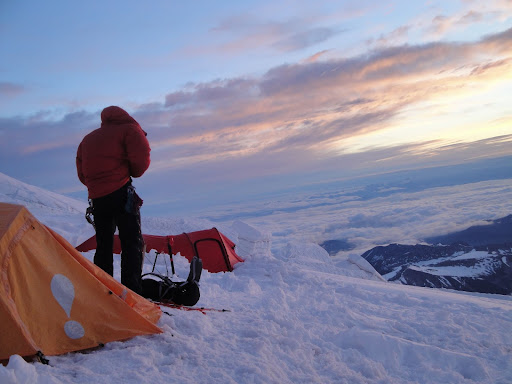In the Fall of 2015, I was 30 pounds overweight and hadn’t stepped foot in a gym in years. I was overworked and compensated for this on weekends with late nights fueled by cheap beer. My idea of working out was going out on a 15-minute jog a few times a week. But realistically, I skipped half of my planned runs and only made it out a few times a month.
Less than a year later, I stood on the summit of Mount Rainier. I would confidently climb Grand Teton, Shasta (Casaval Ridge), and Shuksan (Fishers Chimneys) in the following years.
That first Rainier climb was a life-changing accomplishment for someone like me. I had zero mountaineering experience, lived at sea level, and had been out of shape for years.
So how did I go from a couch potato to climbing some of the more notable peaks in the lower 48?
By chance, I was introduced to the book Training for the New Alpinism. The principles in this book taught me the most important lesson for a beginner mountaineer: How to be fit enough to get to the summit.
In this article, I will highlight the five most important principles I learned from the Uphill Athlete team and how any beginner can use their methodologies to go from zero to summit.
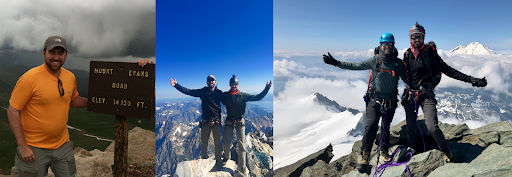
But first, how did I get involved with Uphill Athlete?
In the Fall of 2006, during my freshman year at the University of Tennessee, I stumbled upon a TV show called “Everest: Beyond the Limit”.
Having lived in the Southeast my entire life, I had never been exposed to mountaineering or the idea of climbing something like Everest. Watching a team of people attempting to summit Everest was like watching men walk on the moon.
The show captivated me, and I was drawn to the idea of mountaineering, but it would be another decade before I would even consider giving it a shot.
Nearly 10 years later, a new friend of mine randomly mentioned that he too was obsessed with “Everest: Beyond the Limit” and suggested that we sign up to climb Mount Rainier.
I immediately jumped at the idea, and by the next week, we had a trip in the books to climb Rainier with Alpine Ascents International.
One big problem? I didn’t know ANYTHING about Mount Rainier or what kind of undertaking I had committed to.
Another big problem? I was out of shape, had zero experience, and lived at sea level in Austin, Texas.
But as they say, ignorance is bliss. Signing up for a huge objective (at least for me) and having a friend I was accountable to were the only motivations I needed to get in shape and make this goal a reality.
I embraced the idea of living a healthy lifestyle and implemented habits that increased my daily output. I just needed to learn how to train to accomplish something like climbing a big mountain.
To my surprise, there was very little information on the internet in 2015 on preparing for something like Mount Rainier. Most resources recommended tons of climbing and training at altitude to prepare. Unfortunately, I lived in the flatlands of Texas.
After a few frustrating days researching how to train for mountaineering, I decided to call Alpine Ascents International, and one of the guides recommended I check out Training for the New Alpinism by Steve House and Scott Johnston.
Enter the Ideas of Uphill Athlete
Training for the New Alpinism was on my doorstep in 2 days, and I devoured the entire book in a weekend.
For the first time, the strategy of mountaineering training made sense. It was much more than the typical recommendations of “just go climb”. In one weekend, I was able to put together an entire 9-month plan that would prepare me for Mount Rainier.
Here are the five key takeaways I took from Training for the New Alpinism and how Uphill Athlete is the perfect resource for beginners looking to get to the Summit.
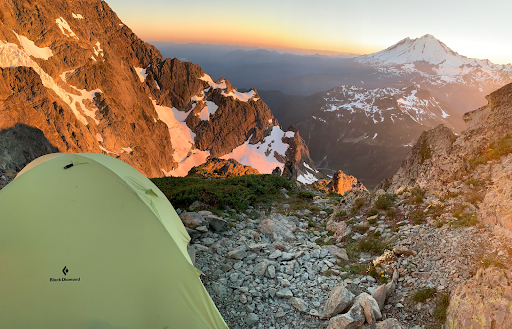
View from Kevin's tent on Shuksan (Fisher Chimneys) in 2020.
5 Uphill Athlete Principles to Help Beginners Summit
Principle 1: Test Yourself
The scariest thing to me when training for Mount Rainier was that I had no idea what kind of shape I needed to be able to summit. Throughout my nine months of training the same thought was constantly on my mind, “am I ready for this?”
In Training for the New Alpinism the recommendation is to periodically test yourself through an “Alpine Combine” to gauge your fitness levels.
Like college football players test a variety of their physical attributes before the NFL draft, you can mimic this in mountaineering by testing fitness levels on six basic exercises.
These basic exercises are:
- Box Step-ups for elevation w/ weighted pack
- Dips
- Sit-ups
- Pull-ups
- Timed box step-ups
- Push-ups
Simply see how many repetitions of each exercise you can do, and grade yourself on the provided rubric scoring system.
The amazing part is that the Alpine Combine exercises are accessible to anyone, even if you live at sea level.
This “Alpine Combine” became my barometer of what kind of shape I was in. I religiously tested at least every eight weeks, and I always wanted to beat my prior score.
Looking back, having a “mini goal” to prepare for every eight weeks motivated me and gave me confidence as I showed tangible improvements.
Principle 2: You Can Do This on Flat Land
The largest disadvantage I had when preparing to climb Mount Rainier was that I lived at sea level in Texas and had limited training options in the mountains.
Rather than winging it or giving up that aspect of my training, I was thrilled to hear this challenge addressed in “Training for the New Alpinism”.
I devoted at least one day per week to muscular endurance for the legs, which meant carrying a pack for an extended period of time uphill.
But how do you do this if you live at sea level?
Here are the recommendations I took from the book that helped me get around this:
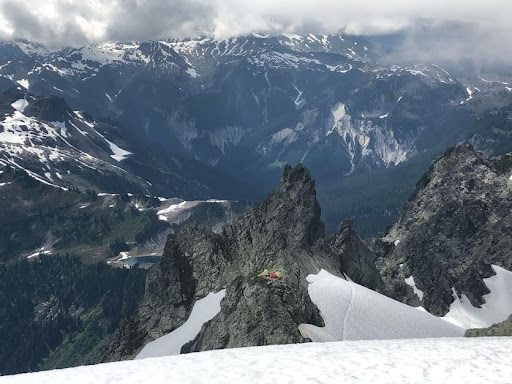
View of high camp at Shuksan after summitting in 2020.
- Box Step-ups: I bought a wooden plyometric box from Amazon, and this quickly became my best training partner. I would spend hours per week stepping on/off the box with a weighted pack. While this was tedious initially, it became second nature while enjoying a podcast or audiobook while doing step-ups.
- Hill Repeats: I found one hill in the Austin area that was super steep and about a quarter of a mile long. I would spend a few days a month carrying a pack up/down this hill for an extended period. It was also a great conversation starter with the neighbors, who thought I was crazy!
- Stadium Stairs: I gained access to a local high school gym and used the stadium stairs for climbing.
Bottom line – You can do Uphill Athlete training if you live at sea level; you may just need to get creative!
Principle 3: Create a Year-Round Training Plan
When I committed to Rainier, I was disappointed in how limited the training resources were online, and I couldn’t even find a training plan (before Uphill Athlete). All recommendations were to climb more, which wouldn’t work for me.
In “Training for the New Alpinism”, I learned how to develop an extended (or even year-long) training plan for my objectives.
Each phase of the training plan was slightly different and would have to be catered to my fitness level and goals.
Learning how periodization worked for mountaineering training was key for me. Exercises and overall strategy would change depending on how close to the climb I was.
My training plan looked a little bit like this:
- Base Training: 17 weeks focused on increasing strength and muscular endurance
- Sport-Specific: 5 weeks focusing more on exercises mimicking what I would be doing on the mountain (in my case, step-ups)
- Taper: 2 weeks to taper and let my muscles recover before the climb
Gaining the understanding that the training plan for a mountaineering objective was a year-long pursuit with different strategies throughout the year was eye-opening to me.
Since I knew my biggest risk was overall fitness, I spent most of my time in the “Base Training” phase, which was focused on building mountaineering-specific strength and endurance.
Using this strategy, I felt super strong all the way to the summit of Mount Rainier.
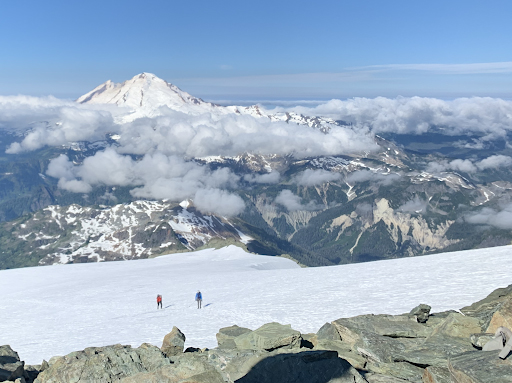
View of Mount Shuksan descent in 2020 with climbers in the distance.
Principle 4: Lift Weights & Build Muscular Endurance
Before I discovered “Training for the New Alpinism”, I heard the same story from everyone I encountered regarding mountaineering training: Go Climb or Run, no need to lift weights.
The problem was – I loved lifting weights, and it didn’t make sense to me that overall strength would not be a help in the mountains.
I learned that the secret to mountaineering is combining muscular strength (how strong you are) with muscular endurance (how long you can be strong).
To be successful, I needed a balance of strength and endurance. And the only way to get strong was to lift weights and mimic what I would do in the mountains.
Using the methodologies and exercises in the book proved invaluable on my summit bid for all the mountains I have climbed. Based on my experience on guided mountaineering trips, most people who fail on the climb do so because they don’t have the overall strength to continue in the mountains for hours on end.
Principle 5: Build an Endurance Machine (Zone 1 & Zone 2)
One of the fundamental ideas in “Training for New Alpinism” is developing aerobic capacity through heart rate zone training.
The basic idea is to calculate your Maximum Heart Rate and then develop training sessions to be within certain heart rate windows.
For mountaineering, most training should be spent in Zone 1 and Zone 2 heart rate. This is a relatively easy effort (conversational pace) for extended periods to replicate long days in the mountains.
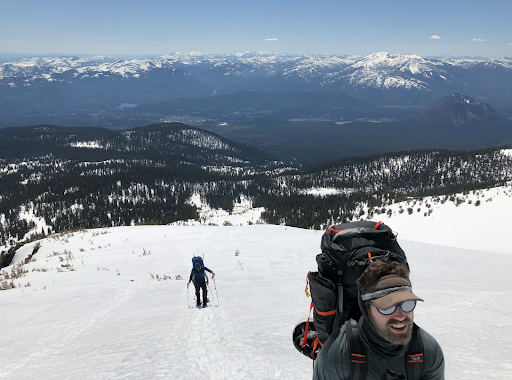
Kevin on Day 1 of the Mount Shasta Casaval Ridge climb in 2019, hiking to camp.
Once I read “Training for New Alpinism”, I realized I had been training for endurance wrong my entire life.
Until then, I was over-exerting myself during cardiovascular exercise and “gritting” it out for as long as I could.
The reality is that I needed to slow down and go for longer distances.
Learning the power of Zone 1 & Zone 2 training was a game changer for me that led to much of my success on mountaineering trips and translated into my ultrarunning success in recent years.
FINAL THOUGHTS
Growing up in the Southeast, the idea of climbing a big mountain was foreign to me.
I decided to climb Mount Rainier on a whim, without realising what I was committing to. I was out of shape and had limited time to put the pieces together so I could attempt to climb with Alpine Ascents International.
I was introduced to “Training for the New Alpinism” and the principles within the book completely changed my perspective on training for mountaineering.
These principles were applied to my training, and over nine months, I was able to lose 30 pounds and get into the best shape of my life. When it came time to climb the mountain, I felt confident, and my fitness level was never in doubt.
Looking back, these five key principles changed the trajectory of my fitness journey I learned from “Training for the New Alpinism”.
The resources at Uphill Athlete are perfect for beginners, and I am proof that anyone (even a guy living in Texas) can figure out how to climb a big mountain like Mount Rainier.
Read more about Kevin’s Journey on his blog.
The five key principles I learned from “Training for the New Alpinism”
- Test Yourself
- You Can Do This on Flatland
- Create a Year-Round Training Plan
- Lift Weights & Build Muscular Endurance
- Build an Endurance Machine (Zone 1 and Zone 2)

